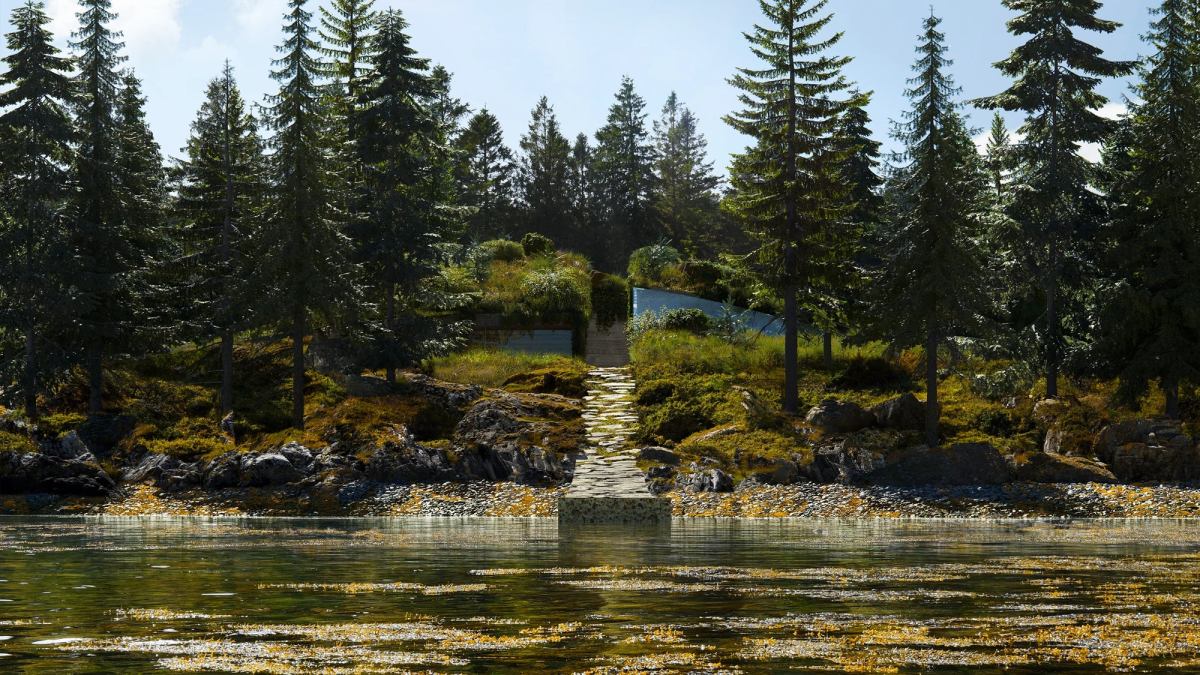[ad_1]
London-based brand Vollebak conceives of future-forward clothing—like a graphene-based jacket, an invisibility cloak and shirts that can endure for 100 years—and now, they’ve designed an island. The ever-innovating brand teamed up with the prolific Bjarke Ingels Group (BIG) to design the plans for Vollebak Island, a roughly 11-acre compound off the coast of Nova Scotia that will be completely run by clean energy.
Carbon neutral and off-grid, the island will be an exploration of how to live in a world that can no longer deny climate change—and proof that this type of life is not only possible but can also be luxurious. When the plot of land and the design vision were presented together for auction earlier this month, through Sotheby’s, the reserve was not met. As such, the project is still available for purchase and in our opinion, needs to come to fruition as a proving ground, statement piece and reference point for how to live well in the future.

Ingels makes a natural partner for Vollebak given the architect’s acclaimed portfolio championing “hedonistic sustainability.” But even beyond that, BIG has already been asking how they can design a world that survives climate change. Vollebak Island is proof-of-concept for the architect’s answer to that question, which they dub the “Plan for the Planet.” The masterplan (already finalized before Vollebak approached them with this project) is a step-by-step guide to creating a carbon neutral Earth that is inhabited by 10 billion people, a population that we are expected to hit by 2058. BIG’s solution involves first converting all energy into clean, carbon-neutral energy by electrifying transport and buildings and creating synthetic e-fuels for anything that can’t be electrified. Then, renewable energy will become local and decentralized yet work on a global and interconnected scale.

When it comes to resources, the plan imagines drawing back from nature and fossil fuels, using land for clean energy, turning crop residue into biomethane and relying only on sustainable agricultural practices to create more livable land, which could then be divided up equally among the billions of people so that each group of four receives a homestead of around a hectare.

Vollebak Island is the first real test of Plan for the Planet. Run entirely on geothermal energy, offshore wind, solar power and ground source heat pumps, these can all be stored within the walls of the island’s buildings. Earth House, the main hub, is set to be a cluster of nine interconnected buildings akin to a small village. Part architecture and part land art, it rises from the ground organically (BIG intends to raise the topography of the land to keep the buildings partly hidden). It will be made from a range of ancient local materials as well as innovative new ones that represents another synergy with how Vollebak makes their clothing. Featuring a bathhouse made with 3D-printed concrete, a living room that uses thatch as its main material, a dry storage area utilizing the island’s abundance of seaweed and a sunken stargazing room and meditation space created using hempcrete (a bio-composite material made of hemp shives, lime and sand). The material is also used to create one of the building’s bedrooms and another is made with boulders.

The building will be carefully constructed to work in tandem with the land which bursts with a lush ecosystem. The roofs, in addition to carrying solar panels, feature shrubs and other flora, reducing storm runoff and easing the strain on water and waste management systems.

The other building on the island will be Wood House, a bunker-like annex that lies on the island’s eastern shores. It is proposed to be made with cross-laminated timber from trees on the island. “Laminated in different directions, it’s a relatively new technology,” says Ryohei Koike, lead architect of the project. “So, it can be as thick as possible and almost as robust as concrete.”

The proposal makes clear that food grown will be grown in the island’s greenhouse (made of brick-shaped glass that’s dyed emerald green) and will be bountiful enough to sustain those living there. Chanterelle mushrooms already grow there, and sea scallops, lobster, crab and sea kelp are abundant in its surrounding waters.

Perhaps as an effort to put new spiritual energy into the place or maybe just to continue researching the seasonal dynamics of this unique location, Vollebak is now taking applications for those looking to stay on the island before its buildings are built. Those residing on Vollebak Island will need to know how to live off-grid, without leaving a footprint behind. Rent will cost $1 per night.

Vollebak Island shows how we can exist reciprocally with the environment. While it may only be a small, isolated test, it offers a model that can be scaled and replicated for towns, villages and cities, emphatically denying that a fatalistic apocalypse is our only inevitability.
Images courtesy of Bjarke Ingels Group
[ad_2]
Source link https://coolhunting.com/design/vollebak-and-bjarke-ingels-sustainable-island-of-the-future/

Leave a Reply
You must be logged in to post a comment.